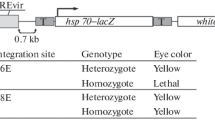Abstract
The P elements of Drosophila melanogaster are well-studied transposons with both mobilizing and repressor functions. P elements can also variably silence the expression of certain other transgenes through a phenomenon known as P element-dependent silencing (PDS). To examine the role of the P repressor in PDS, we have induced, isolated, and characterized 22 point mutations in an archetype P element called P[SalI]89D. All mutations showed a loss in the ability to silence one or more assays for the PDS phenotype. These mutants also lost the ability to induce the suppression of variegation in P[hsp26-pt-T]39C-12, another P element-dependent phenotype. A subgroup of 11 mutations was further assayed for their ability to act as a P repressor and silence the P element promoter transcribing a lacZ + gene, and this function was lost as well. Taken together, this study supports a model of PDS acting through protein interactions, not RNA, with heterochromatic proteins to modify the extent of variegation seen in PDS. Furthermore, the common loss of functions for PDS and P repressor silencing (from another P promoter) argues for a common role of the repressor. This makes the PDS model a good system for examining P repressor functions and how they relate to transposon-mediated gene silencing in general.






Similar content being viewed by others
References
Adamczak RA, Porollo A, Meller J (2005) Combining prediction of secondary structure and solvent accessibility in proteins. Proteins 59:467–475
Bier E, Vaessin H, Shepherd S, Lee K, McCall K, Barbel S, Ackerman L, Carretto R, Uemura T, Grell E (1989) Searching for pattern and mutation in the Drosophila genome with a P-lacZ vector. Genes Dev 3:1273–1287
Black DM, Jackson MS, Kidwell MG, Dover GA (1987) KP elements repress P-induced hybrid dysgenesis in Drosophila melanogaster. EMBO J 6:4125–4135.
Blom N, Gammeltoft S, Brunak S (1999) Sequence and structure-based prediction of eukaryotic protein phosphorylation sites. J Mol Biol 294:1351–1362
Brennecke J, Aravin AA, Stark A, Dus M, Kellis M, Sachidanandam R, Hannon GJ (2007) Discrete small RNA-generating loci as master regulators of transposon activity in Drosophila. Cell 128:1089–1103
Brennecke J, Malone CD, Aravin AA, Sachidanandam R, Stark A, Hannon GJ (2008) An epigenetic role for maternally inherited piRNAs in transposon silencing. Science 322:1387–1392
Bushey D (2004) Characterizing P element dependent silencing in Drosophila melanogaster. PhD dissertation, University of Alberta, Edmonton Alberta, Canada
Bushey D, Locke J (2004) Mutations in Su(var)205 and Su(var)3-7 suppress P-element-dependent silencing in Drosophila melanogaster. Genetics 168:1395–1411
Eaton S, Kornberg TB (1990) Repression of ci-D in posterior compartments of Drosophila by engrailed. Genes Dev 4:1068–1077
Engels WR (1989) P Elements in Drosophila melanogaster. In: Berg DE, Howe MM (eds) Mobile DNA. ASM Press, Washington, pp 437–484
Ephrussi B, Herold JL (1944) Studies of eye pigments of Drosophila. Methods of extraction and quantitative estimation of the pigment components. Genetics 29:148–175
Gattiker A, Gasteiger E, Bairoch A (2002) ScanProsite: a reference implementation of a PROSITE scanning tool. Appl Bioinformatics 1:107–108
Jensen PA, Stuart JR, Goodpaster MP, Goodman JW, Simmons MJ (2008) Cytotype regulation of P transposable elements in Drosophila melanogaster: repressor polypeptides or piRNAs? Genetics 179:1785–1793
Jones D (1999) Protein secondary structure prediction based on position-specific scoring matrices. J Mol Biol 292:195–202
Marsden RL, McGuffin JL, Jones DT (2002) Rapid protein domain assignment from amino acid sequence using predicted secondary structure. Protein Sci 11:2814–2824
Mul YM, Rio DC (1997) Reprogramming the purine nucleotide cofactor requirement of Drosophila P element transposase in vivo. EMBO J 16:4441–4447
Ng PC, Henikoff S (2003) SIFT: predicting amino acid changes that affect protein function. Nucleic Acids Res 31:3812–3814
O’Hare K, Rubin GM (1983) Structures of P transposable elements and their sites of insertion and excision in the Drosophila melanogaster genome. Cell 34:25–35
Pollastri G, McLysaght A (2005) Porter: a new, accurate server for protein secondary structure prediction. Bioinformatics 21:1719–1720
Riley J, Butler R, Ogilvie D, Finniear R, Jenner D, Powell S, Anand R, Smith JC, Markham AF (1990) A novel, rapid method for the isolation of terminal sequences from yeast artificial chromosome (YAC) clones. Nucleic Acids Res 18:2887–2890
Rio DC, Laski FA, Rubin GM (1986) Identification and immunochemical analysis of biologically active Drosophila P element transposase. Cell 44:21–32
Robertson HM, Engels WR (1989) Modified P elements that mimic the P cytotype in Drosophila melanogaster. Genetics 123:815–824
Sun F-L, Cuaycong MH, Craig CA, Wallrath LL, Locke J, Elgin SCR (2000) The fourth chromosome of Drosophila melanogaster: interspersed euchromatic and heterochromatic domains. Proc Natl Acad Sci USA 97:5340–5345
Author information
Authors and Affiliations
Corresponding author
Additional information
Communicated by R. Paro
Electronic supplementary material
Below is the link to the electronic supplementary material.
Supplementary Figure 1
Eye color phenotypes of ln(1)w m4 stock, a classic hPEV allele. Su(var)s increase the frequency of the suppressed phenotype (b), while E(var)s increase the frequency of the variegated phenotype (a) in the progeny (JPEG 104 kb)
Supplementary Table 1
Testing the P-Sal-M* mutations for antimorphic effect on P-Sal (DOC 68 kb)
Supplementary Table 2
Effect of P-Sal-M* mutants on P{hsp26-pt-T}ci 2-m1021.R eye color (DOC 68 kb)
Supplementary Table 3
Effect of P-Sal-M* mutants on P{hsp26-pt-T}39C-12 eye color variegation (DOC 68 kb)
Supplementary Table 4
Effect of P-Sal-M* mutants on E1 (DOC 67 kb)
Rights and permissions
About this article
Cite this article
Sameny, A., La, A., Hanna, S. et al. Point mutations in a Drosophila P element abolish both P element-dependent silencing (PDS) of a transgene and repressor functions. Chromosoma 120, 573–585 (2011). https://doi.org/10.1007/s00412-011-0332-y
Received:
Revised:
Accepted:
Published:
Issue Date:
DOI: https://doi.org/10.1007/s00412-011-0332-y




